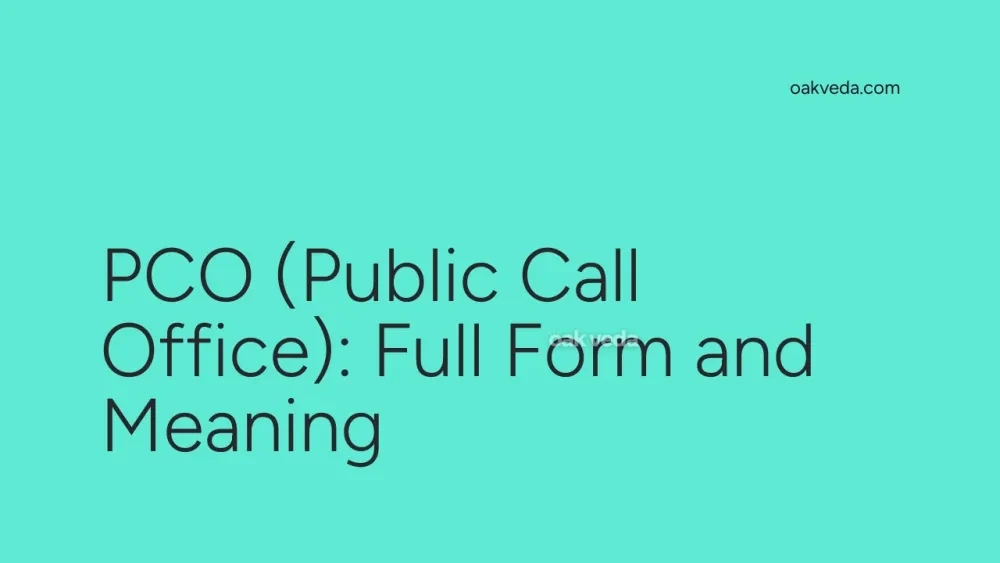
What is the Full Form of PCO?
PCO is an abbreviation with multiple full forms, but in the context of telecommunications, PCO stands for Public Call Office. This term refers to a public facility that provides telecommunication services, primarily telephone calls, to the general public.
What is a Public Call Office?
A Public Call Office, commonly known as PCO, is a designated location in a public area that offers telecommunication facilities. These facilities were once a crucial and successful means of affordable communication, especially in developing countries like India. PCOs played a significant role in connecting people before the widespread adoption of mobile phones and personal communication devices.
Origin and Development of Public Call Offices
The concept of Public Call Offices emerged as a solution to provide accessible and affordable communication services to the masses. In India, PCOs gained popularity in the 1980s and 1990s when personal telephone connections were scarce and expensive. The government-owned Bharat Sanchar Nigam Limited (BSNL) was one of the largest operators of PCO networks in the country.
How does a Public Call Office work?
A typical PCO operates on a simple principle:
- Users visit the PCO booth
- They request to make a call to a specific number
- The operator connects the call using the available telephone line
- Users pay for the duration of the call, often using coins or prepaid cards
- The operator disconnects the call upon completion
PCOs usually charge per minute or per pulse, making it an affordable option for short-duration calls.
Types of Public Call Offices
While the basic concept remains the same, there are different types of PCOs:
- Coin-operated PCOs: Users insert coins to make calls
- Card-operated PCOs: Prepaid cards are used to pay for calls
- Operator-assisted PCOs: An attendant manages the calls and collects payment
- STD/ISD PCOs: Offer long-distance (STD) and international (ISD) calling services
Functions of Public Call Offices
The primary functions of PCOs include:
- Providing accessible communication services to the public
- Offering affordable calling options for local, long-distance, and international calls
- Serving as a communication hub in areas with limited telephone infrastructure
- Facilitating emergency communications in remote areas
Applications of Public Call Offices
PCOs have various applications, including:
- Enabling communication with out-of-station or overseas relatives
- Providing a platform for business communications in areas with limited connectivity
- Serving as emergency contact points in rural or underdeveloped regions
- Offering fax and other basic telecommunication services
Features of Public Call Offices
Key features of PCOs include:
- Affordability: PCOs offer cost-effective communication solutions
- Accessibility: Located in public areas for easy access
- Privacy: Booths often provide a level of privacy for callers
- Reliability: Managed by operators ensuring consistent service
- Versatility: Many PCOs offer additional services like fax and internet access
Benefits of Public Call Offices
PCOs have provided numerous benefits, especially in developing countries:
- Bridging the communication gap: PCOs connected people who couldn't afford personal phones
- Economic opportunities: PCOs created employment for operators and booth owners
- Emergency services: Provided crucial communication during emergencies
- Digital inclusion: Introduced many to telecommunication services
- Community hubs: Served as information centers in many localities
Limitations or Challenges of Public Call Offices
Despite their benefits, PCOs face several challenges:
- Declining relevance: With the rise of mobile phones, PCO usage has significantly decreased
- Maintenance issues: Keeping coin-operated machines functional can be challenging
- Security concerns: PCO booths can sometimes be targets for vandalism or theft
- Limited services: Compared to modern smartphones, PCOs offer limited functionality
- Hygiene concerns: Shared equipment can raise hygiene issues, especially in pandemic situations
Future Developments in Public Call Office Technology
While traditional PCOs are becoming obsolete, the concept is evolving:
- Internet kiosks: Some PCOs are transforming into internet access points
- Digital service centers: PCOs are being repurposed as centers for digital services like bill payments and online form submissions
- Community Wi-Fi hubs: In some areas, PCO infrastructure is being used to provide public Wi-Fi services
- E-governance centers: PCOs are being utilized as access points for e-governance initiatives
FAQs on PCO Full Form
-
What is the primary full form of PCO in telecommunications? The primary full form of PCO in telecommunications is Public Call Office.
-
Are PCOs still relevant in the age of mobile phones? While PCOs have declined in relevance, they still serve a purpose in areas with limited mobile connectivity or for people without access to personal phones.
-
Who operates PCOs in India? Initially, BSNL was the largest PCO network operator in India. Now, private telecom companies like Tata, Reliance, Idea, Airtel, and Vodafone also operate in this sector.
-
What other services do modern PCOs offer besides phone calls? Modern PCOs may offer services like internet access, fax, photocopying, and digital payment facilities.
-
Is PCO the same as STD/ISD booth? While similar, STD/ISD booths specifically offer long-distance (STD) and international (ISD) calling services, whereas PCOs may offer both local and long-distance services.
In conclusion, while the traditional Public Call Office may be fading into history, its impact on telecommunications and public access to communication services remains significant. As technology evolves, the spirit of PCOs lives on in new forms of community-based digital services.
You may be interested in:

